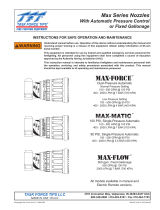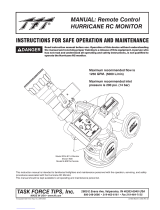
©Copyright Task Force Tips LLC 1999-2020 4 LIM-030 November 16, 2020 Rev15
1.0 MEANING OF SAFETY SIGNAL WORDS
A safety related message is identified by a safety alert symbol and a signal word to indicate the level of risk involved with a particular
hazard. Per ANSI Z535.6, the definitions of the four signal words are as follows:
2.0 SAFETY
OPERATING NOTE ABOUT AUTOMATIC NOZZLES: The automatic nozzle is considerably different than Fixed and Selectable Flow
nozzles because of basic changes in the operating principle. These differences not only assure the most effective operation under a
variety of conditions, but will also utilize the available water supply most efficiently. It is important that nozzle operators, pump operators,
and officers be fully aware of these differences. Therefore, proper instruction is required for safe and effective operations.
DANGER indicates a hazardous situation which, if not avoided, will result in death or serious injury.
WARNING indicates a hazardous situation which, if not avoided, could result in death or serious
injury.
CAUTION CAUTION indicates a potentially hazardous situation which, if not avoided, could result in minor
or moderate injury.
NOTICE is used to address practices not related to physical injury.
An inadequate supply of pressure and/or flow will cause an ineffective stream and can result
in injury or death. Choose operating conditions to deliver adequate fire suppression. See flow
graphs.
This equipment is intended for use by trained personnel for firefighting. Use of this equipment for
other purposes may involve hazards not addressed by this manual. Seek appropriate guidance and
training to reduce risk of injury.
Injury or damage can occur from an inadequately supported monitor. The mounting must be
capable of supporting the nozzle reaction force which can be as high as 1500 lbs.
Some volatile liquids can be ignited by static discharge, which can occur during application of foam
or water. Fire or explosion can result in injury or death. Follow procedures established by the AHJ
to reduce risk of fire or explosion caused by static discharge.
Application of water or foam solutions on energized electrical equipment could cause
electrocution. Serious injury or death could result. Assume circuits are energized until confirmed to
be de-energized. Do not apply water or foam to energized electrical equipment.
The stream exiting a nozzle is very powerful and capable of causing injury and property damage.
Make sure the nozzle is securely attached and pointing in a safe direction before water is turned on.
Do not direct water stream to cause injury or damage to persons or property.
Equipment may be damaged if frozen while containing significant amounts of water. Such damage
may be difficult to detect visually. Subsequent pressurization can lead to injury or death. Any time
the equipment is subject to possible damage due to freezing, it must be tested and approved for
use by qualified personnel before being considered safe for use.
To prevent mechanical damage, do not drop or throw equipment.





















